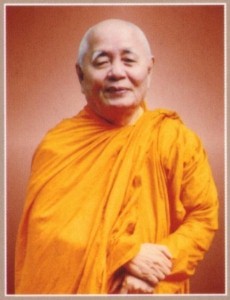The Most Venerable Maha Thera was a taciturn person with an unforgettably kind smile on His bright round face. His half-open, half-closed eyes looked gently and steadily at things in front of Him as if He were in deep meditation. He was fully aware of what was going on around Him, but was not actually disturbed by any of the surrounding phenomena. Before His body got weak (due to the Parkinson's disease which he seemed to have contracted in the early 1980s), he would walk agilely and energetically. Besides the time reserved for His Dharma practice and dissemination, from early dawn to late at night, He would be sitting at the desk either in His own room upstairs in Van Hanh Zen Monastery, or in His Office in the Buddhist Institute located at the same address. He would focus on His work tirelessly with great concentration. Occasionally there were some guests, visitors, or disciples whom He had to receive. Then, near the end of the day, He would spend His late afternoons sitting alone in His simple bamboo rocking chair on the balcony, looking into the void in front of Him in that meditative posture which was always part of Him.
He ate simple vegetarian meals, and preferred salt to soy sauce. He often drank tea, and usually had a glass of milk in the afternoon. He had a small, old grey car which Venerable Thich Tam Duc, one of His disciples, would drive to take Him when He needed to go to the airport, or some temples and places for meetings with government authorities or Buddhist dignitaries.
The Most Venerable Maha Thera was charismatic, calm and taciturn, but He would never try to impress others. He would scarecely talk about Himself. In His speech, He always used the pronoun "we" to refer to Himself, instead of "I." He would not want to build big temples nor accept many disciples. In His Dharma talks, He usually said that each person should be his or her own torch. He was a simple and task-oriented bhikkhu, and a very caring human. Once in 1988, despite His busy schedule, He managed time to come to the hospital to visit His translator who was also an instructor at the Buddhist School of Higher Studies (former name of the Buddhist Institute in Ho Chi Minh City) , and who had just recovered after a narrow escape from a traffic accident.
Both before and after 1975, his main focus was always on Buddhist education, and on how to disseminate the Buddha's authentic teachings based on Pali sutras to His Vietnamese Buddhists and laypeople. He set a very clear goal for Himself when He left Vietnam for further Buddhist training in 1952: to study Buddhism as it was originally taught by the Buddha Himself over 2,500 years ago, and, through formal education, to teach Buddhists and laypeople how to apply what the Buddha taught to their daily life, so that they might benefit from Buddhist teachings in their own lives, and bring peace and harmony to life on earth. From His young adulthood to the end of His life, He devotedly served Buddhism, never perturbed by any comments or criticisms. With persistence and perseverance, He kept working on what He had vowed to accomplish in life. He was solid like a mountain, not moved or disturbed by what others said about Him. Following the Buddha's example, He would never argue with anybody in the mundane world.
During His Dharma talks one could find peace and joy, and the Dharma taste of liberation right here and now. He highly revered the Buddha's words, and would present the sutra as it had been originally recorded from the Buddha's times. In His translations, He would retain the repetitions in the sutra, word for word, knowing that it was the best way for one to absorb and benefit from sutras. Listening to the Most Venerable Maha Thera, one might have the impression as if one were reliving the Buddha;'s times, and listening to the Buddha Himself.
Near the end of His life, despite His declining health, the Most Venerable Maha Thera kept on teaching, translating, and completing tasks the Buddhist Sangha assigned Him. He did not stop working until He became too weak and had to rely on a wheel-chair, and the help of His close disciples. He could have received medical treatment in the 1980s, but He probably refused to go to Japan for any treatment or surgery. The reason of his refusal might probably be that He did not want to waste people's time and money, for He had already known Parkinson's was uncurable.


